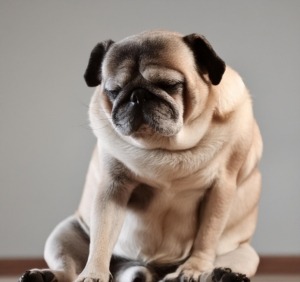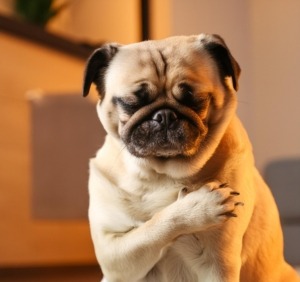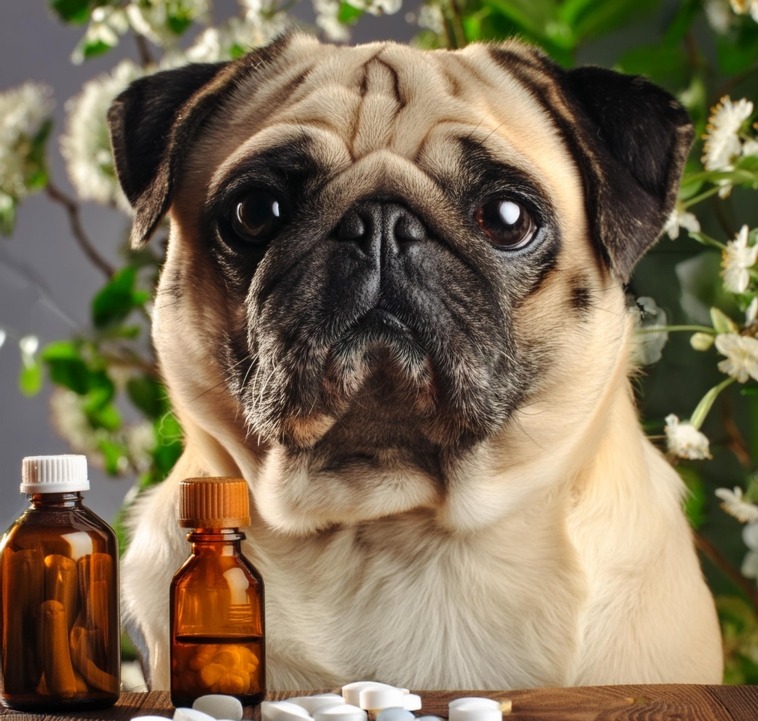Last updated on September 27th, 2024
Here’s an overview:
The usual suspects – top five allergens for pugs
Pollen Allergies in Pugs: Signs, Symptoms and Relief
Dealing with Food Allergies: Discovering and Dealing with Pug Dietary Sensitivities
Flea Allergy Dermatitis (FAD) Treatment Options for Pugs
Household Allergens and Your Pug: Dust Mites, Molds, etc.
Contact Allergies: Textiles And Surfaces That May Irritate Your Pug
Allergy Testing for Pugs: When to See a Vet and What to Expect
Medication and Supplements: Alleviating Allergy Symptoms in Pugs
Natural Remedies and Preventative Measures for Pug Allergies
Dietary Changes and Nutrition: Boosting Your Pug’s Allergy Resistance
Setting Up an Environment That Does Not Trigger Allergies for Your Pug
In conclusion, Managing Pug Allergies for a Happy, Healthy Life
Introduction to pug allergies
Pug Allergies: Pugs are popular pets because of their distinctive features and loving personalities. They may react to various things as environmental allergens such as pollens dust mites ; molds foodstuffs fleas materials used in making toys beds etc. It is important that people know these signs early enough so that they can take care of them before they worsen into more serious health issues . Therefore knowing what signs indicate there is an allergy taking place would help you provide timely intervention which could save life during this critical period since some symptoms may become life threatening if not addressed immediately.
The usual suspects – top five allergens for pugs
Just like humans, pugs too suffer from allergies which can greatly affect their overall well-being if not managed properly. Therefore understanding what these allergens are and how to identify them will help a lot towards preventing such conditions from occurring in future.
- Pollen: This is one of the most common types of allergies experienced by people all over this world during spring season when plants start blossoming again after winter hibernation period When it comes into contact with skin or gets inhaled through nose or mouth it causes sneezing itching among other signs.
- Dust Mites: They are very tiny creatures that cannot be seen with naked eyes but cause great discomfort on anyone who comes into contact with them especially those who have sensitive skins like babies or people suffering from eczema. These pests thrive best in warm environments such as beddings, carpets, upholstered furniture etc.
- Moulds: spores produced by molds found mostly within damp areas like basements, bathrooms ceilings where there’s poor ventilation system also trigger off allergic conditions due inhalation/ingestion.
- Food Allergies: Just like humans dogs can also be allergic to certain foodstuff hence owners should watch out for any unusual behavior after consuming particular meals e.g. beef; chicken; fish ; pork etc.
- Fleas: Flea saliva contains substances that irritate an animal’s skin resulting severe itchiness commonly referred as (FAD). The affected part becomes red inflamed causing hair loss due excessive scratching thus leaving behind sores which are prone infection.

Pollen Allergies in Pugs: Signs, Symptoms and Relief
Pugs have high chances of getting affected by pollen allergy. These are some signs;
- Itchy skin
- Runny nose
- Watery eyes
- Sneezing fits
- Redness on the skin
Inhalant allergies may lead to itchy skin resulting into secondary bacterial infections. To get a right diagnosis, take note about when these symptoms appear most or worsen during the peak times of pollination.
Symptomatic Relief Strategies
- Regular Baths: Use hypoallergenic shampoo to clean off the pollen from the fur coat of your pug.
- Air Purifiers: Install in the house so as to cut down on airborne allergens.
- Foot Soaks: Wash their paws after taking walks outside to remove any traces of pollens.
- Antihistamines: Seek advice from the veterinary officer before administering them .
- Immunotherapy: It can be given under strict supervision by a vet when allergic reactions become severe.
These measures will greatly reduce discomfort brought about by this type of allergy hence giving relief against it for your pet .
Dealing with Food Allergies: Discovering and Dealing
It’s important to look out for symptoms such as itching, gastrointestinal upsets, and chronic ear infections when addressing food allergies in pug puppies. One method of finding out what specific allergens they might have is through an elimination diet.
- Supplying them with hypoallergenic or limited ingredient diets
- Introducing novel protein sources into their meals
- Implementing a rotation feeding strategy where different types are given on different days
- Consulting vets about suitable supplements or medications they may need to be put on
Regular monitoring and veterinary check-ups will be necessary to keep them healthy if they suffer from any form of dietary sensitivities.
Flea Allergy Dermatitis (FAD) Treatment Options for Pugs
When it comes to treating fleas on pugs there should be no room left for error because this can easily lead to complications later on down the line therefore everything must be done right from start till finish;
- Flea Control: Apply topical flea preventatives, use oral medications or place collars as prescribed by the vet in order get rid of current infestations plus preventing future ones.
- Anti-Inflammatory Medication: Corticosteroids may help reduce inflammation while antihistamines could relieve itching although prescription needs to come from the vet.
- Medicated Baths: Soothing shampoos would provide relief against skin irritations thus forming part of treatment plan often recommended too.
- Fatty Acid Supplements: Allergic reactions could reduce themselves thanks omega-3 fatty acids that support good health for the skin hence these might work best here.
- Environmental Control: Wash bedding regularly; vacuum floors frequently etc., this will decrease risk of exposure thus lowering chances of getting infected with fleas.
- Immunotherapy: Allergy shots can be given when signs are severe so as to desensitize the immune system from reacting badly towards flea allergens.
This should be done under veterinary guidance since they know what is best for each individual case and would also consider safety standards during treatment procedures.
Household Allergens and Your Pug: Dust Mites, Molds, etc.
Pugs have a high risk factor when it comes down onto household allergies mainly caused by common allergens. Dust mites happen to be one significant source indoor allergen which thrives mostly in warm humid areas like fluffy carpets or bedding materials. With their wrinkled faces and small bodies, pugs tend to come into close contact with these microorganisms easily.
To fight against such irritants ensure that there is low humidity maintained at all times while frequently washing fabrics in hot water. Use anti-allergen covers for mattresses and pillows too thus reducing exposure levels towards dust mites further on.

Besides this mold also poses great danger towards health status especially respiratory functions among other things. Furry animals with long hair bring pollen into homes which could worsen your pug’s allergy symptoms even more so wipe its body using wet cloth after walks then establish no-shoes policy indoors lest it harbors outdoor allergens thereby affecting those already present inside house.
Keeping household free from various types of allergens will prevent unnecessary suffering therefore work out ways through which you can manage them effectively without compromising dog’s well-being.
Contact Allergies: Textiles And Surfaces That May Irritate Your Pug
There are certain textiles or surfaces encountered daily by dogs including pugs may cause irritation due allergic reactions being triggered in their bodies. To avoid this;
- Natural fibers like cotton should be preferred over synthetic ones when buying your pug new beddings so as to reduce chances of any form contact allergy occurring.
- Avoid using woolen blankets or carpets since these tend irritate sensitive skins characteristic among pugs mainly attributed this breed’s unique features which include deep wrinkles around face area etc.
- Use hypoallergenic wash detergents void dyes & perfumes on any fabric washed within home especially those meant for use around animals such as pets including dogs themselves not forgetting cats too if applicable.
- In order to decrease exposure to allergens, clean surfaces regularly using gentle cleaners safe for pets.
By considering the things in which your Pug comes into contact with, you can help prevent contact allergies.
Allergy Testing: When to See a Vet and What to Expect
It is important to consult with a veterinarian if your pug has symptoms such as constant scratching, skin irritation or respiratory problems. These are signs of allergy which may worsen if not treated correctly. During the visit:
- The first thing that will be done is a physical examination.
- If there are signs suggesting an allergic reaction, the vet may recommend testing for allergies.
- Tests can include patch testing on the skin or blood tests to identify specific allergens.
- The veterinarian will also tell you how best prepare your Pug and what should be done during this time of testing.
Once we have the results from these tests, our next step would be making a personalized treatment plan so as to relieve itching in pugs caused by allergies while at the same time improving their overall health status.
Medication and Supplements: Alleviating Allergy Symptoms
When dealing with allergies in pugs, particular medications and supplements may be recommended by a veterinarian to manage symptoms effectively. Furthermore, omega 3 fatty acid supplements promote healthy skin thus lowering allergic responses. Ensure that you follow all instructions provided including dosage guidelines before starting any therapy since failure could lead into serious consequences on your dog’s life
Natural Remedies and Preventative Measures for Pug Allergies
To minimize effect of allergies among pug puppies; new owners can try out various natural remedies as well as preventive measures which include:
- Maintain Cleanliness: Regular cleaning reduces allergens. Bathe them weekly using hypoallergenic shampoo while ensuring that you also use fragrance-free laundry detergent for their bedding.
- Dietary Adjustments: Incorporate anti-inflammatory foods like omega-3 fatty acids to potentially soothe skin irritation.
- Paw Care: After taking walks outside it is important rinse your pug’s paws so as remove outdoor allergens from them.
- Natural Supplements: Consult a vet whether or not adding natural supplements such as quercetin or coconut oil into your pugs’ routine could boost their immune system response towards allergies.
- Regular Grooming: To avoid matting of fur and accumulation of allergens, brush them on a daily basis.
- Allergy-Specific Cleaning: Use damp cloth when wiping down face folds of your pugs which will reduce yeast and bacteria buildup in these areas.
Consistency with these measures is key to reducing allergic reactions as well as ensuring comfort for the pet
Dietary Changes and Nutrition: Boosting Resistance
A good diet plays an important role in boosting immunity against allergies among dogs including Pugs. You should introduce balanced meals that contain;
- High-quality proteins
- Omega-3 & Omega-6 fatty acids
- Fresh fruits together with vegetables which are rich in antioxidants

These changes foster healthy skin while at the same time reducing inflammation within their bodies. Additionally probiotics or limited ingredient diets can also work towards this goal by creating healthy gut environment necessary for proper functioning of immune system linked closely with each other. Ensure you consult a vet before making any dietary modifications to meet specific nutritional needs of your dog.
Setting Up an Environment That Does Not Trigger Allergies
It is important to clean where you live if you want to keep your pug from getting allergies. Here’s what you need to do:
-
- Washing of Beddings: To eradicate dust mites, wash your pug’s bedding every week using hot water.
- No Carpets: Allergens can be trapped in carpets; hence it is better to have hard floors.
- Control Humidity: Mold will not grow if you maintain indoor humidity below 50%.
- Covers that block allergens: Employ covers that are resistant to allergens on both the pugs’ beds and yours too including mattresses & pillows.
- Time for bath: Regularly bathe your pug with hypoallergenic shampoos meant for sensitive skins.
- Smoke free environment: It would be wise for one to ensure their house remains smoke free as this could worsen allergies.
In conclusion, Managing Allergies for a Happy, Healthy Life
Managing pug allergies requires commitment and being proactive. With continuous effort these adorable pets will prosper and live comfortably without any signs of allergy problems in their lives.




